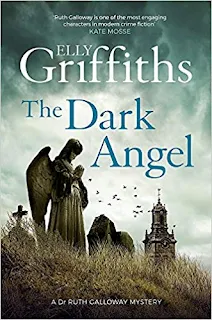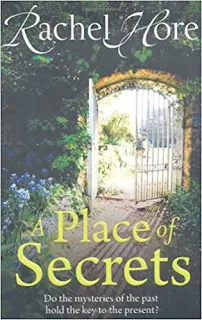In case you're interested, here are the posts from the rest of the year: January, February, March, April, May, June, July, August, September, October, November
And here are my reviews of the novels I read in December...
Devil's Day by Andrew Michael Hurley (2017)
I should probably start this with a confession… I haven’t read The Loney (Hurley’s acclaimed debut novel), which makes me one of the only people I know who hasn’t. I included Devil’s Day on a list of books about autumn traditions last year, but didn’t actually get chance to read it until this winter. It’s a strange book – not because of the subject matter (I really don’t mind strange subject matter!) – but in terms of its inconsistency. It has moments of absolute brilliance, but also some sections that don’t really seem that well-written. The story unfolds in a non-linear fashion (great) with an unreliable first-person narration disguised at times as third-person (even better). John and his wife Kat have returned to his family’s farm at the Endlands for his grandfather’s funeral, intending to stay on for Devil’s Day and the Gathering (traditions on the farm that presage the start of winter). As the story of that year’s Devil’s Day unfolds, older stories are woven in – the Arncliffes who built the mill, the Dennings who once owned the land, events from John’s childhood, the presence of the Owd Feller himself. There is an incredible sense of place evoked in the book, and I particularly enjoyed the episodes involving the Far Lodge (a building one of the Dennings had constructed on the land). However, there is less clear sense of character created, and I struggled to engage much with any of them. Ultimately, perhaps the Endlands itself is the best-drawn character here.
A Midwinter Promise by Lulu Taylor (2019)
So… bit of a misstep, this one. In December, we went away for our annual holiday to Cornwall. The weather was wild, but we were cosy and warm in our cottage. All year, I’d been saving Christmas-themed books to read while we were there. However, on our first night away, I spotted A Midwinter Promise in the supermarket and decided that it would make perfect holiday reading. The blurb promised (a) winter, (b) secrets, and (c) Cornwall. I bumped it to the top of my list, casting aside all the festive books I’d been saving. And, sadly, I was very disappointed. Taylor’s book begins with a woman called Alex reminiscing about her childhood at Tawray, a rambling old house in Cornwall. When Alex’s dad has a stroke, she starts to wonder about her mother’s early death, and about the secrets that may have been kept by her family. The book then alternates this storyline with chapters set in the 70s, 80s and 90s, which tell the story of Julia (Alex’s mother) and her life at Tawray. The problem with the book is that (a) it’s only partly set in the winter, (b) although characters keep secrets from one another, Taylor doesn’t keep any secrets from the reader and so Julia’s story is crystal clear from the off, and (c) Tawray may nominally be located in Cornwall, but there’s very little sense of place, save a few mentions of how nice the sea looks. Really not impressed with my decision here.
The Darkest Place by Jo Spain (2018)
Back to the books I’d been saving for my holiday… as I’ve mentioned in previous months, my mum and I really like Jo Spain’s DCI Tom Reynolds novels. In fact, it was last December when I read the first in the series and passed it on to my mum. The Darkest Place is the fourth book in the series – though I’ve actually already read the fifth one (I read them out of order so that I could save this one for going away). The Darkest Place is set at Christmas (like With Our Blessing) and sees Reynolds called away from his family celebrations (as in With Our Blessing) to investigate a crime in a remote – and very creepy – location (as in…). The setting for The Darkest Place is a disused asylum on an island, which is accessible only by boat. A mass grave has been discovered, but there’s a body in it that shouldn’t be there. Psychiatrist Dr Conrad Howe disappeared at Christmas forty years earlier, and it now appears he was brutally murdered and left in the hospital grave pit. Reynolds is faced with opening up a cold case, which leads him into the dark heart of the asylum and its ‘treatments’. The Darkest Place treads familiar ground – Spain often returns to darker aspects of Ireland’s history in her books – and its lighter on the personal lives of the detectives than some of the others. Nevertheless, this is a satisfyingly creepy story with a clever puzzle at its centre.
Murder in Advent by David Williams (1985)
I’m not having the best luck with my festive reading this year. This next one was another book I was saving till Christmas, as I thought it would be a good seasonal read. I actually bought it in a charity shop in Truro last Christmas, but I didn’t chance to read it then. I’ve saved it all year, only to discover… it’s not actually a Christmas book at all (despite the title). Murder in Advent is set in the small (fictional) cathedral city of Litchester. The cathedral owns a thirteenth-century exemplification of the Magna Carta, which they are considering selling to raise much-needed funds for the cathedral. Banker Mark Treasure (apparently Williams’s series character) arrives, as he has a deciding vote in the matter, but before anything else can happen, there’s a disturbance in the Old Library. The Dean’s verger is killed, and a fire destroys the valuable artefact. The problem I had with the book (aside from the fact that Advent and Christmas aren’t actually part of the story) is that I simply couldn’t follow who was who. The key characters are introduced in a dazzling chapter early on, and there are a lot of them. If you’re unfamiliar with church roles and titles – if you don’t know what a Dean’s verger is, for instance – it’s a bit of a tricky read. And it’s made harder by the fact that all the characters seem to speak in a similar voice. Sadly, this one just didn’t do it for me.
Mistletoe by Alison Littlewood (2019)
Now this is festive reading. Just what I wanted! Littlewood’s book has all the elements you want from a Christmas book… snow, an isolated farmhouse and ghosts. The book is the story of Leah, who is recently bereaved (she’s lost her husband and young son), and so decides – impulsively – to leave Manchester and buy an abandoned farmhouse in Yorkshire. At Christmas. Buying the farmhouse was Leah’s late husband Josh’s idea, and so she believes this is a way of honouring his memory by trying to bring his dream to reality. The farm – Maitland Farm – once belonged to Leah’s family, so it seems like fate might be playing a hand as well. But when Leah arrives at Maitland Farm, in the darkest depths of winter and heavy snowfall, she discovers that it may be harbouring some grief of its own. Mistletoe is a classic Christmas ghost story, and Littlewood is adept at conjuring an atmosphere that is equal parts tragedy and horror. Leah’s experience of the ghosts of Maitland Farm comes through visions, which take on a life of their own. The past and the present begin to blur, with the eponymous parasitic plant weaving its way through the stories. I’d be wary of calling this a ‘cosy’ story, as there are some disturbing elements, but it certainly belongs to a good old tradition. The ghost story (or the story of the ghosts), perhaps, holds few surprises. But the way that it’s told is just wonderful, and I thoroughly enjoyed it.
The Secret Santa by Trish Harnetiaux (2019)
I picked this one up in the supermarket on a whim (despite having collected more than enough festive books over the year). There were a couple of reasons why it caught my attention. A couple of years ago, I wrote a piece of flash fiction called ‘Secret Santa’, and since then I seem to keep getting drawn to writing weird versions justice-dispensing Father Christmases. Secondly – and more importantly – the blurb looked like it’d be a good old-fashioned ‘everyone’s locked in the house getting picked off one-by-one’ tale. Claudine and Henry Calhoun are high-flying real estate types in Aspen. Every year, they throw a fancy Christmas party, which involves a competitive Secret Santa game that’s the talk of the town. This year, Claudine’s been contacted by pop star Zara (who bears some slight similarity to a real-life pop star who shall remain nameless). Zara is interested in buying Montague House, the first property Claudine and Henry ever built, and so Claudine decides to move the party to the somewhat remote building. The snow starts to fall, the guests assemble, and there’s an additional gift on the Secret Santa pile… This book was a lot of fun – it’s a quick read, and not necessarily the story you might be expecting, but I really enjoyed it. The tension is well-paced, and Zara emerges as a rather engaging character. Plus, there’s a bit of intrigue, secrecy and rivalry as well. I’m glad I picked this one up – it was a very enjoyable festive read.
The Hunting Party by Lucy Foley (2018)
Managed to time my festive reading so I could end the year with a New Year-themed book! The Hunting Party takes place during a New Year’s Eve party, so it was the perfect way to end December. A group of old university friends meet up for their annual New Year’s Eve celebrations – this year, they’ve booked an exclusive (but isolated) hunting lodge in the Scottish Highlands. Over the course of the booze-fuelled party, old secrets and resentments surface… and someone’s not going to survive the party. The book is much marketed as an ‘Agatha Christie with menace’ (hmmm… I think Christie’s books had enough menace of their own!), but it’s also been compared to Tartt’s The Secret History (which I didn’t enjoy). However, the book actually does its own thing, and it’s not really fair to compare it to Christie or Tartt’s work. There was a lot that I really enjoyed about The Hunting Party. I loved the multiple narrators, and I was impressed with how easy it was to keep track of a large group of characters. Most of the characters are a bit unlikeable (as you’d expect), but they were very believable and Foley snuck in just the right amount of sympathy. I also enjoyed the way the landscape is used to create an additional sense of seasonal threat. Only downside… Foley’s not quite at Christie’s level when it comes to hiding clues, and so I did work it out very early on. Nevertheless, definitely enjoyed this one.
Happy New Year!













































